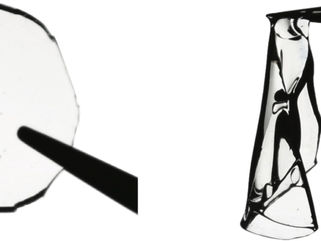Insulated Nanowires based on a new composite material -
Electrically conducting polypyrrole nanofibers in a silicate matrix
Electronic components keep getting smaller. The next generation of opto-electronic components will get down to nanoscopic dimensions. Naturally, "wiring" on the same scale is needed for technological applications. However, ordinary metallic wires are not suitable in this case. Instead, materials such as conducting polymers are generating a lot of interest. Scientists at the University of Tokyo have developed a new method for the production of such tiny wires made of polypyrrole -- it even includes the insulating sheath required for a cable. The fundamental idea of using parallel nanoscopic channels made of certain silicate materials as a kind of mold for the nanowires is not entirely new. Previous attempts to "stuff" these little channels with monomeric building blocks and then to get them to polymerize did yield interesting results, but did not lead to a breakthrough success. This led the Japanese research team, headed by Takuzo Aida, to modify the method. Rather than putting the pyrrole monomers into pre-existing channels, they generate the channels in the presence of the "filling". They thus make a solution containing the starting materials for the silicate, as well as the building blocks that are to become the polypyrrole. In order for it all to work, the building blocks must also have an additional feature: they must have the properties of a surfacant. Surfacants are surface-active substances used in such products as shower gels and detergents. In aqueous solutions they form micelles. When a thin film of the reaction mixture is spread on a support and dried, the tenside-pyrrole hybrids form long, tubular micelles, around which the silicate crystallizes. This results in long, parallel, hexagonal channels in the silicate framework; these channels are filled with tenside-pyrrole units. The researchers then cause the pyrrole units to polymerize, in an astonishingly rapid and complete reaction. It is clear that the inclusion of the monomer units within the silicate channels plays an important role in this process. "The result is a composite material consisting of long, individual bundles of polypyrrole fibres that are embedded in a silicate matrix and demonstrate good electronic properties," explains Aida. "These composite films can be seen as polypyrrole nanocables with a silicate sheath as insulation."
Most read news
Topics
Organizations
Other news from the department science
These products might interest you

Eclipse by Wyatt Technology
FFF-MALS system for separation and characterization of macromolecules and nanoparticles
The latest and most innovative FFF system designed for highest usability, robustness and data quality

Spinsolve Benchtop NMR by Magritek
Spinsolve Benchtop NMR
Spinsolve is a revolutionary multinuclear NMR spectrometer that provides the best performance

HYPERION II by Bruker
FT-IR and IR laser imaging (QCL) microscope for research and development
Analyze macroscopic samples with microscopic resolution (5 µm) in seconds

Get the chemical industry in your inbox
By submitting this form you agree that LUMITOS AG will send you the newsletter(s) selected above by email. Your data will not be passed on to third parties. Your data will be stored and processed in accordance with our data protection regulations. LUMITOS may contact you by email for the purpose of advertising or market and opinion surveys. You can revoke your consent at any time without giving reasons to LUMITOS AG, Ernst-Augustin-Str. 2, 12489 Berlin, Germany or by e-mail at revoke@lumitos.com with effect for the future. In addition, each email contains a link to unsubscribe from the corresponding newsletter.



















































